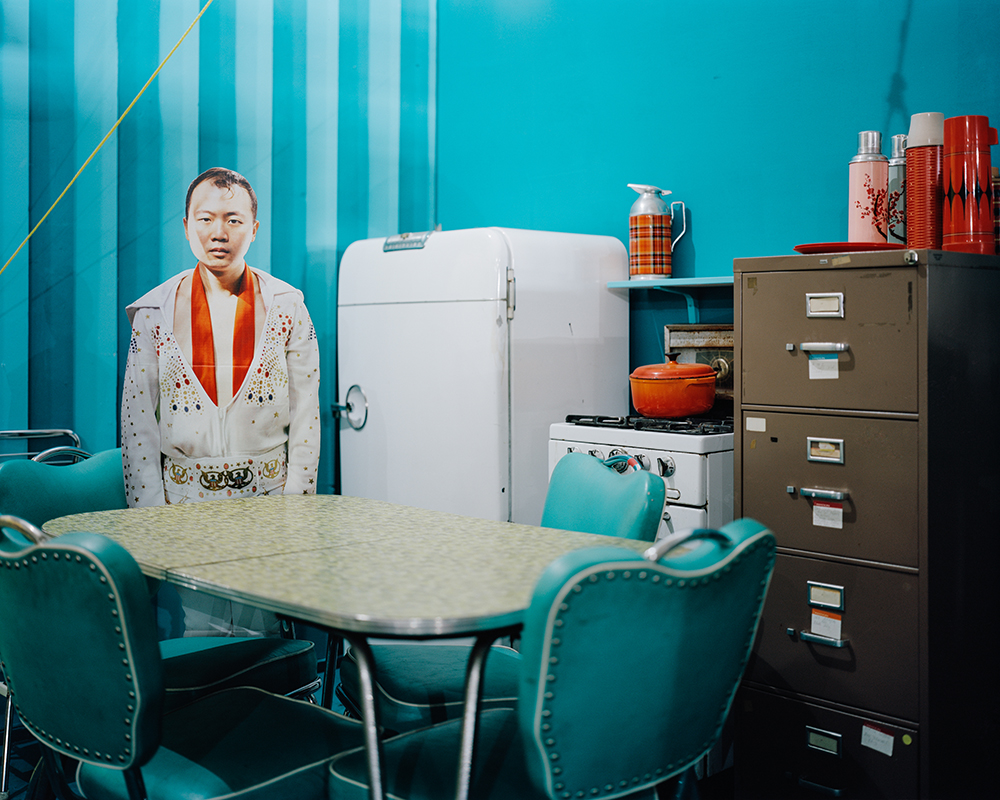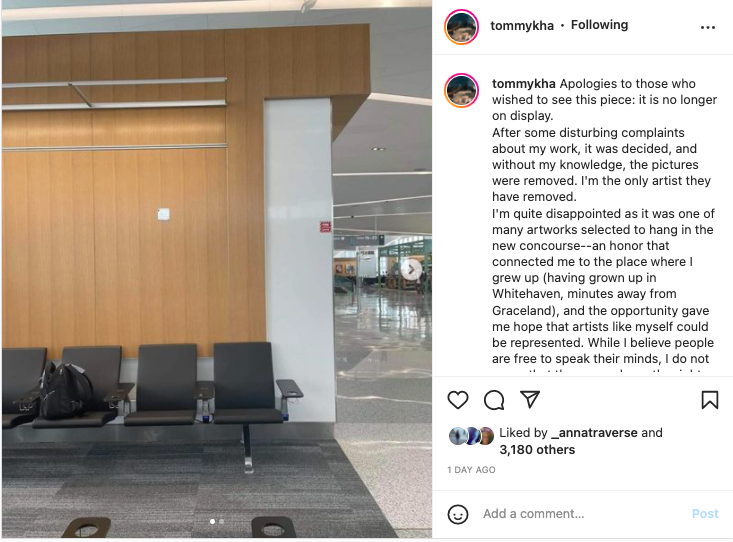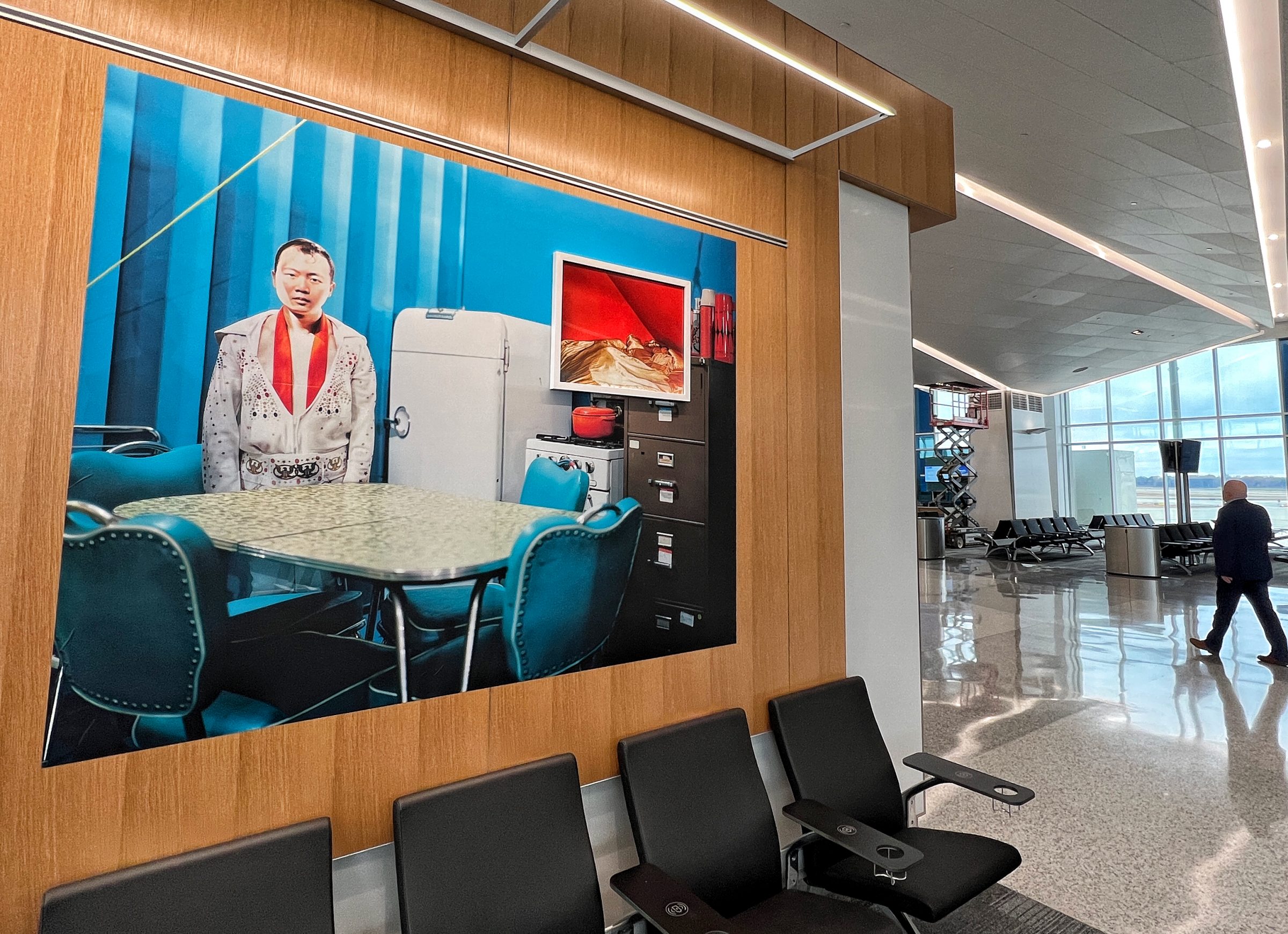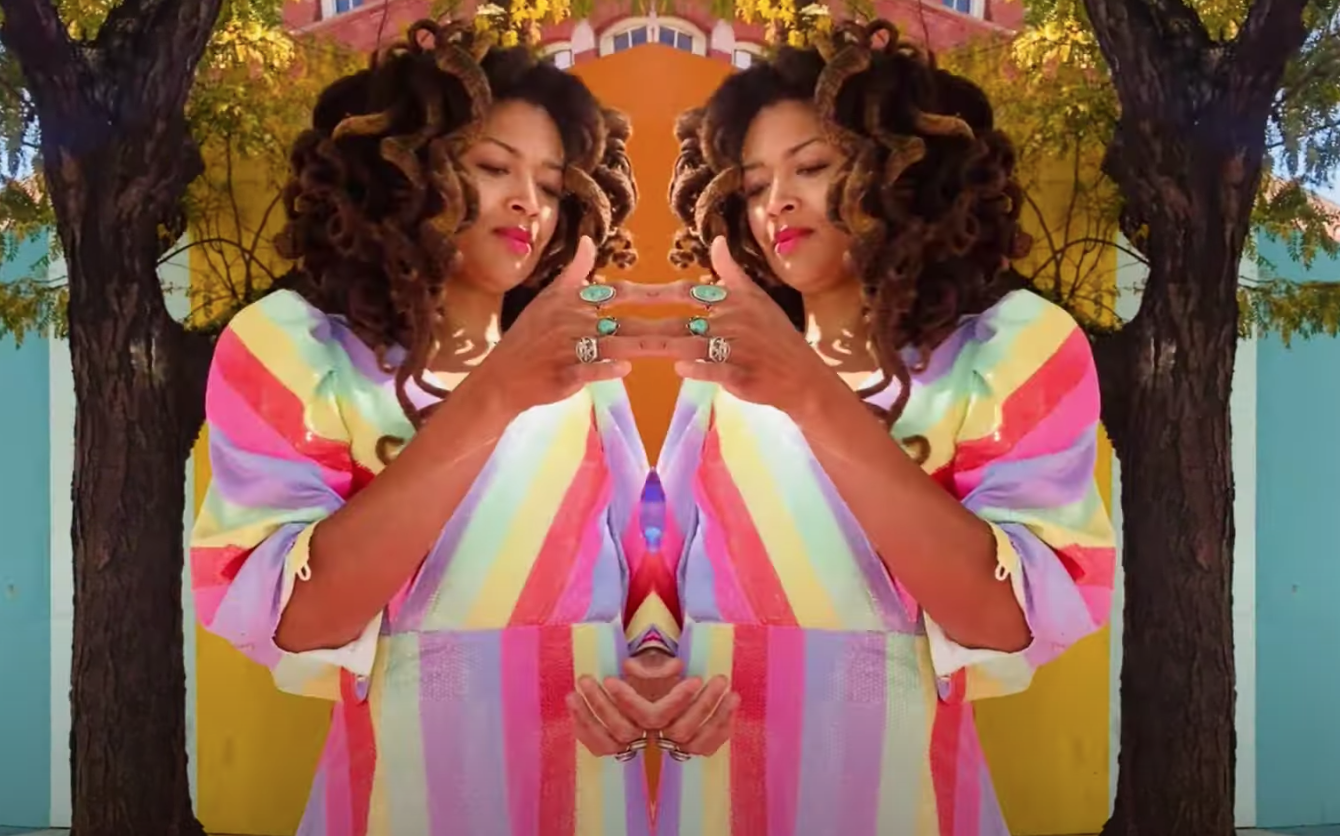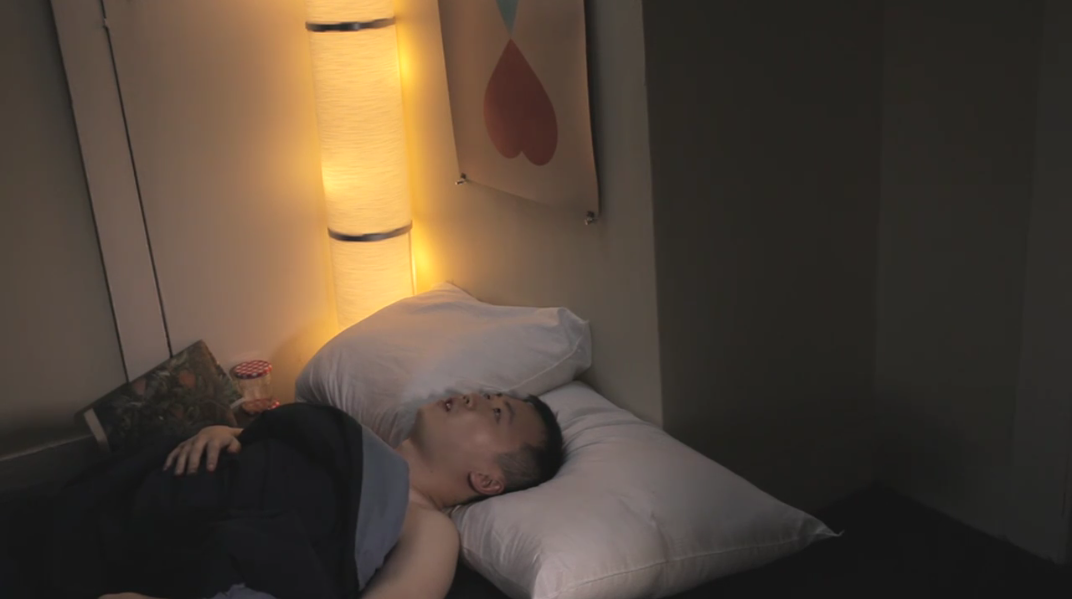Tommy Kha has always had trouble in airports. The Memphis-born, New York-based fine art photographer uses a variety of props in his photographs — life-sized cardboard cutouts, Greek busts, improbable kitsch baubles — all of which make for peculiar carry-on luggage. Passing through airport security on his way to photo shoots across the country, Kha would often have to have what he terms “the conversation” with Transportation Security Administration agents. “I got the most responses when I was carrying 3-D printed plastic masks of my face,” Kha told the Memphis Flyer. TSA agents would become suspicious when they discovered the lifelike masks peering out of Kha’s baggage. Kha would hurry to explain to the officers: “It’s for art!”
In recent weeks, Kha once again found himself having to explain his artwork in an airport. Only this time, Kha’s work wasn’t hidden in luggage, but displayed in large format on the airport walls. And this time, “the conversation” played out on an international stage, between livid social media posts, corporate boardrooms, and in the press. The firestorm over Kha’s photo series, Constellations VIII/Golden Fields, led to the artwork’s removal and subsequent reinstallation within a week. It garnered the Memphis International Airport accusations of censorship and racism and roped in such unlikely players as the mayor of Memphis, the host of an HGTV show, The Advocate magazine, a notable Hollywood film director, and the CEO of Memphis’ largest tourist business.

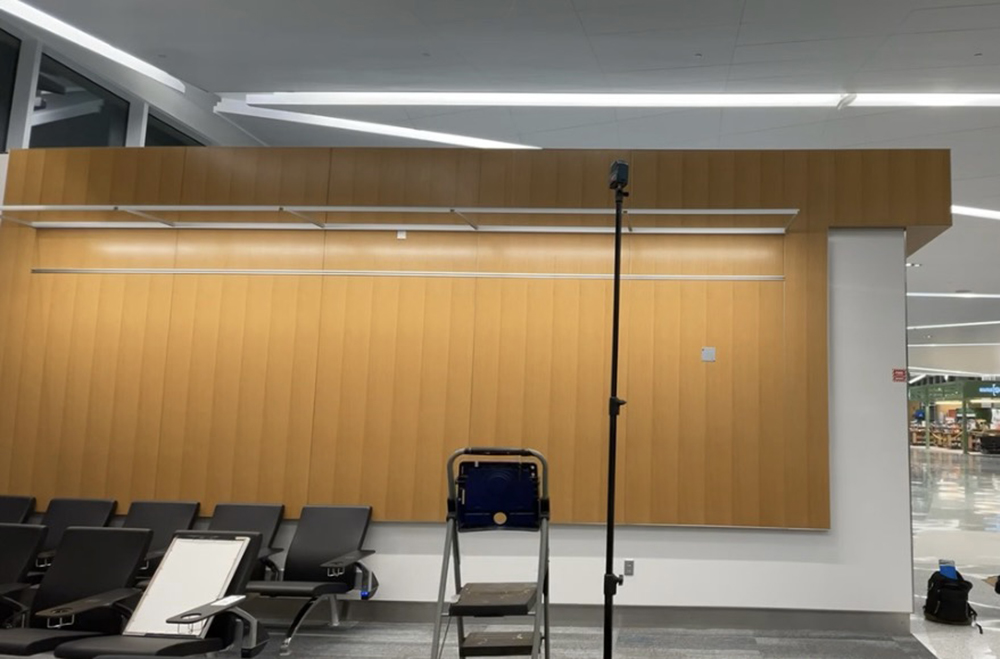
It might be difficult to explain why Kha’s photos elicited such a dramatic public response to anyone not from Memphis, but Memphians will have no problem understanding. Kha’s photographs depicted Elvis Presley. Memphians know that whenever Elvis is involved, there’s a high chance of — to quote the artist Don Lifted from his social media post about the controversy — “Memphis Memphis’ing.”
A New Symbol and an Old Icon
In early March, Jon Daly arrived at the newly renovated Memphis International Airport to catch a flight to Denver. Daly, who owns the nearby Elvis Presley Boulevard Pawn Shop, was excited to see the airport’s new Concourse B. The $245 million project both downsized and modernized an airport that, in its previous incarnation, more closely resembled an off-hours bus station than an international flight destination. Once a busy hub, Memphis International has struggled in recent years with declining crowds, a loss that airport CEO Scott Brockman described to The New York Times in 2018 as “death by a thousand cuts.” Brockman feared that the decline of the airport symbolized something greater to Memphians, about the transformation of the city from a bustling urban center to a place that no longer felt like “a real city.” Concourse B was an attempt not only to save the airport as a functional utility but to renew the airport as a symbol of a resilient Memphis.
The remodel opened in January 2022 to much praise. The renovation replaced low ceilings and beige brick with soaring glass galleries. Gleaming restaurants and stylish gift shops operate amid spacious gate seating. The crowning jewel of Concourse B, occupying nearly every square foot of wall, is a million dollar contemporary art collection sourced from predominantly local visual artists. The tourism blog ILoveMemphisBlog.com called the art collection “The coolest part of the new terminal.”
When Jon Daly arrived at Memphis International for his trip, he expected to be impressed. Daly travels frequently around the country in search of Elvis Presley-related memorabilia and archival material for his shop. His business in Whitehaven is near both Graceland and the airport; when he’s not listening to Elvis records, he is listening to the drone of planes flying low. “Being a big Elvis fan, I was excited to see how they would honor Elvis in the airport,” said Daly. As he progressed through the concourse, however, he became frustrated. “I didn’t see Elvis in the airport. I did see this artwork, and I’ve got to be honest, it was very disheartening.”
The artwork that Daly saw was Kha’s. The piece consists of two photographs. The first — Constellations VIII, installed as a large vinyl sheet directly on the wall — is a self-portrait of Kha dressed in a white bejeweled Elvis-style jumpsuit and red scarf, standing in a blue retro kitchen. Kha’s black hair is twisted into a gelled pompadour. He stands impassively behind a table, looking neither elated nor upset and appearing strangely flat. The flatness derives from the fact that the Kha in the photo is in fact a cardboard cutout of Kha, a prop of himself that he made to insert in his photos. The second photo, Golden Fields, is installed in a small frame set within the first photo. It features a red room and another cardboard cutout, this one a golden Elvis Presley, lying prone in gold sheets.
These were not the photos of Elvis that Daly had imagined. He was expecting to see Elvis in an iconic light. He wanted a figure closer to the one he’d first admired as a 6-year-old, a wax sculpture in a museum in Myrtle Beach. There, Elvis was dressed in his Aloha in Hawaii getup, complete with a floor-length white cape. To the 6-year-old Daly, Elvis looked like “a superhero” at a time when Daly needed a superhero. Growing up in rural Ohio, he had what he describes as “a rough early life” and Elvis’ gospel music and movies helped get him through. Said Daly, “I would come home and put on Elvis on Tour or Girl Happy. And then it would be okay.” In 1999, he went to his first Elvis Week and met friends who “are more like family now.” These days, Daly is an informal figurehead for Elvis fans and collectors internationally. He lives in Memphis, runs his own Elvis festival, and has a sizable online following of other Elvis aficionados.
After seeing Kha’s photograph in the airport, Daly did what people do when they want to air grievances — he posted on Facebook. He wrote, “The new $245 million dollar wing of the Memphis airport is nice and new. For those of you flying in for Elvis Week … the city of Memphis has forgotten Elvis fans. I saw no photos of him or Graceland. This however is half of a wall near the bathrooms. What a joke.” He posted an image of Kha’s artwork and tagged the Memphis International Airport in the post.
The post immediately went viral among Elvis fans. Nearly 300 people commented, and many shared it. The comments ranged from confused (“Seriously Jon what does this represent? What is it advertising?” and “Who is that supposed to be in the jumpsuit?”) to livid (“The idiots running Memphis need to realize without Elvis nobody would care about their city!!!!” and “This is disgusting!”) to threatening destruction (“Needs a little spray paint.”)
Comments also involved Kha’s race. A commenter named Karol Donath described Kha as “Kim Jong Un in a poorly made copy of Elvis Stage wear.” In response to a commenter asking, “And what the hell does that picture mean?” a commenter named Alan Wade said “It means they don’t want to offend the black community …” A commenter named Paul Snell asked, “Has the Chinese bought the airport too?” Daly told the Flyer that he attempted to delete “ignorant” comments and does not support racism.
To Daly, Kha’s work was just one more mockery of Elvis that reduced the singer to pop-culture punchline. Daly interpreted the refrigerator in Kha’s photo as a reference to Elvis’ poor eating habits in the last years of his life. He didn’t like the fit of the jumpsuit. But when asked what else, besides the setting, struck him as disrespectful and mocking about the photo, Daly also brought up Kha’s race: “My thought process on that would be, if we were going to go to the Detroit airport, would we have someone who is Asian dressed up as The Temptations? Probably not, because Motown is a very respectable record company. If we were to go to the Nashville airport, would we see someone who is of Asian descent dressed as Dolly Parton? Or Hank Williams Sr.? No, we would not … so if we are not going to do it in Detroit and we are not going to do it in Nashville, why is it okay to represent Elvis in that light?”
Kha looking like he does in the photo — a short Asian man in an ill-fitted, cliched jumpsuit — confirmed to Daly that “Elvis is not viewed as a historic figure” in Memphis. In Daly’s view, there was no way that Kha’s Elvis could be anything other than a mockery. Many fans seemed to share Daly’s sentiment. Within hours, hundreds of Elvis fans from all over the world had flooded the airport authority, Elvis Presley Enterprises, and the city of Memphis with comments demanding the photo’s removal.
The story could have ended there, with a few hundred Elvis fans, upset because their favorite singer didn’t look the way they wanted him to. But it didn’t. Instead, the airport listened.
Tommy Kha as Andy Kaufman as Elvis Minus the Singing
In their evaluation of the photograph, the Elvis fans had gotten one thing wrong. Constellations VIII is not a portrait of Elvis. It is a portrait of Tommy Kha.
Tommy Kha grew up, almost literally, in the shadow of Graceland. He attended Graceland Elementary (which closed in 2013) and remembers school field trips where he and his classmates would walk around the walls where Elvis fans signed their names. As a young person, Kha was “not exactly a fan” of Elvis, but he didn’t have to be. Elvis was everywhere, a fact of life, a figure whose name decorated streets and marked the change in seasons. For Kha, Elvis Week represented the end of summer and the beginning of the school year.
Kha is a second-generation immigrant from a Chinese-American family who came to Memphis following the Vietnam War, when the city opened its doors to refugees. He grew up in a neighborhood that shifted from a white suburb to a predominately Black one following bussing in the 1970s, a place starkly defined by Black and white racial politics. Whitehaven — an enclave of one-story red brick homes with small carports and neat front lawns — is the kind of place that families move to pursue the American Dream. Kha’s family was no different. He attended Overton High School and Memphis College of Art. As a young artist, he often felt invisible but found community in Memphis’ punk art and music scenes. In the late 2000s, it seemed impossible to go to a rock show in Midtown without running into Kha, crouched near the band behind a large camera.
In the years since graduating MCA, his talent carried him far away from Whitehaven. His meticulous formal photography, which takes visual cues from William Eggleston, earned him a place in Yale’s prestigious MFA program. His photos of Memphis build on Eggleston’s colorful vernacular of the South but twist it into the South that Kha knows — one of quiet curtained backrooms that threaten as much as they welcome. Kha’s South is a place where things don’t appear quite as they are or even as they pretend to be, a place where even the facades are fading.
Kha speaks softly and punctuates his sentences with quick laughter. His presence is at once unassuming and unforgettable; once you’ve met Kha, you know him forever. He dresses a little bit like a dandy, in coordinated jackets and ascots. Throughout his life, Kha has made work about his identity — a queer Asian-American man from the South — and work that makes a visual pun of his appearance. In one photograph, he stands in only his underwear next to a towering redhead. In a short video, he slumps on a pool bench next to a powerfully built man flexing his pectoral muscles. He likes unlikely couples and twins, look-alikes, and opposites. Kha knows he doesn’t look like the American masculine ideal, and he uses that knowledge to play with viewers’ expectations.
Kha didn’t really get interested in Elvis until he left Memphis. At grad school in New Haven, he felt homesick and lonely. He bought his first cardboard of Elvis because he needed “someone to keep me company,” and Elvis reminded him of home. He would use the cutout to help him frame shots, to focus his camera. He didn’t find a way to really incorporate Elvis into his work until 2015, when he met an Elvis tribute artist in Brooklyn. “I thought it would be amazing to make a body of work that is sort of about Memphis but through the filter of meeting [tribute artists] from all over who are doing this thing that I think is art.” That year, he returned to Memphis to photograph the tribute artists at Elvis Week. He watched hours of Andy Kaufman videos in preparation. He made a video piece called “Tommy Kha as Andy Kaufman as Elvis Minus the Singing.” He also tried his hand at performing as Elvis but realized that he was “not a performer in that regard.” What he prized most about this work were the conversations, the fleeting connections he felt with the Elvis community.
He also felt a peculiar joy in his own failure to be Elvis or imitate Elvis. “I thought it was more poetic to talk about not being able to look the part at all or actually be an Elvis tribute artist. It is not about mockery, but about my own failures. I always try to place myself in a position of disparaging myself.”
Another thing the Elvis fans who critiqued Kha’s photo got wrong: If there is a joke in Constellations VIII, the butt of the joke isn’t Elvis. It’s Tommy Kha.
Kha does not mind being the punchline of a joke, so long as it is a joke he has constructed. And so long as, when you get it, you’re not sure if you should really be laughing.
A Respectful Representation
When Kha got a call, on March 10th, that the airport was considering removing Constellations VIII because of controversy it had caused among Elvis fans, he was distraught. He was also not surprised.
Kha hasn’t had the best luck showing in the South. In past showings, his work had been spit on, censored, and threatened with destruction. He’s had work go missing and displayed incorrectly. He only submitted to the airport’s call for artists because he was specifically invited by the project managers, the UrbanArt Commission (UAC). He also submitted because, for Kha, there is something that feels different about being recognized as a Southern artist, rather than a gay artist or an artist of color, though he identifies as both. Said Kha, “I know I am from the South, but it is one thing to be seen and to know yourself as a certain way, and it is another thing to be seen by other people that way. I always thought of myself as an artist, but I never considered how it would feel when other people started looking at me and seeing me as an artist.”
The airport offered that visibility.
Kha initially submitted a series of pictures from a decade-long project called “Return to Sender,” or “Kissing Pictures,” photos that show Kha receiving kisses from many different people and not returning them. One of the submitted photos shows Kha being kissed by another man. In January of 2021, they were initially accepted by a subcommittee and then rejected after debate among a larger decision-making committee. Kha felt that the photos were not accepted because they depicted a same-sex kiss, and he felt let down. Here, again, was a Southern exhibition he would not be able to participate in because his work spoke too plainly about his own Southern experience.
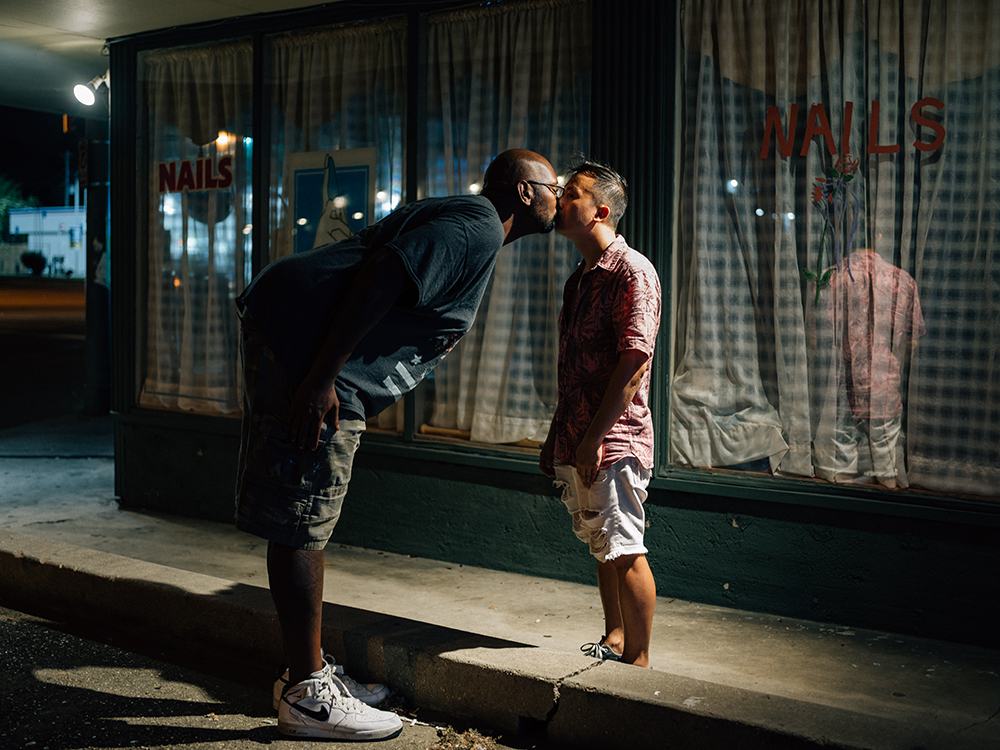
In January, he wrote to the UAC, “I owe a lot to Memphis, I still make work about it. But I wish to push for the ‘Kissing Pictures’ as I think the work is fresh, peculiar, and, more importantly, could reflect nicely for Memphis to open to art that isn’t necessarily safe or censored, it’s really about what is possible, and in Memphis, one could do that. What can hope and progress look like by opening up to art that can be reflective and offer new voices?” From there, he let it drop.
That summer, UAC approached him again and suggested that he instead submit a few of his other works, some of which referenced Elvis. Kha was still wary, worried about complaints from the Elvis Estate, but he decided to go forward with the submission. In late August, he found out the work had been approved by the board for purchase. He was happy, even a little stunned to be a part of the collection, which includes work by 62 artists with Memphis connections, half of whom are artists of color.
His happiness was short-lived.
On March 10th, Kha was contacted by Lauren Kennedy, the director of the UrbanArt Commission, telling Kha that complaints from Elvis fans might lead to his piece’s deinstallation. Kennedy was on vacation with her husband, driving through a remote part of West Texas. She’d spent the day frantically attempting to find high ground with cell phone service so that she could speak to the people at the airport authority and determine exactly what was going on. She’d been aware of the Facebook complaints but initially, said Kennedy, “I was more amused than concerned. I didn’t expect it to become what it did. It escalated really quickly. Within the day, it escalated to the airport saying they were being told to take it down, which I understand to have been a board decision.”

No one could give her exact information on who was involved: “I know the airport got a lot of complaints, though I don’t know what ’a lot’ means numerically. I was told that the mayor’s office had been contacted and that in some capacity Elvis Presley Enterprises participated in some kind of conversation. But I don’t know who that included and what was communicated.” Both the mayor’s office and Elvis Presley Enterprises denied multiple requests for comment on this story.
Kennedy strongly cautioned the airport against removing the piece. “We thought it was a really bad idea. … We shared our thoughts on how things could transpire if it did come down and just really advocated to keep the piece up.” But the airport did not heed Kennedy’s warnings or wait to remove the piece. Over the weekend, without notifying either Kennedy or Kha, Constellations VIII/Golden Fields came down.
On Wednesday, March 16th, Kha met via Zoom with Kennedy and the airport’s communications manager, Glen Thomas. Kha scribbled two notes to himself to prepare for the meeting: “You did not do anything wrong” and “I love Memphis. I’m from Memphis. I love Elvis and I love the community.” In the meeting, the airport explained that they’d received complaints, some of which were racially motivated. They’d decided to “temporarily” remove Kha’s piece — a move that effectively destroyed the piece’s delicate vinyl. The decision was made, according to the airport, because they now saw the piece and its depiction of Elvis as too much of a “lightning rod.” They worried about tourism during Elvis Week. In the meeting, Kennedy pressed the airport: “It is hard to see the decision to remove without it seeming like giving into the ugly racist part of what has been shared,” she said. “That needs to be addressed.”
Kha was asked if he would consider doing a recommission for the space, which he declined. “I’ve been trying to avoid this,” said Kha. “If that is how people feel — okay. … It just feels like I was left out of the conversation. To even consider a recommission for me is exhausting. … It is a really upsetting thing.” Kha became emotional in the meeting. “I teach students how to navigate a world where they will face this sort of thing and I think that conversation is way more important than what happens to me in this moment.”
Speaking Out
Kha shies away from controversy. He knew that if he wanted to speak about the piece’s removal, he had a platform to do so: In New York as well as Memphis, his work is well-known, and his fans include members of the national press and prominent artists. He is followed by around 30,000 people on Instagram. But he felt tired. He’d tried to avoid being in this position. He was teaching and chasing several deadlines. Was saying something even worth it? Would he look like a complainer?
When he decided to post something to Instagram that let people know what happened, it was after reading the formal statement from the airport on Monday, March 21st. The statement from the airport emphasized that they did not want “public figures or celebrities” in the work, that the purchase of Kha’s work had been an exception to that concern. It also said that “Among the complaints, there were a small number of comments that included language that referred to Mr. Kha’s race, and such comments are completely unacceptable. The Airport Authority does not support those comments, nor does it form the basis for the Authority’s decision regarding the piece.”
For Kha, this felt like erasure. The complaints that the airport had listened to called for a respectful representation of Elvis. “I know,” said Kha, “that ‘respectful representation’ is code. It just immediately reminded me of how much I have to explain myself. Explain why I am in the room, why I am here. What does that mean, ‘respectful representation?’ It is just another way to say ‘Where are you from? Why are you here? Why is this here?’”
On Instagram, Kha once again found himself having to explain.
“After some disturbing complaints about my work, it was decided, and without my knowledge, the pictures were removed,” he posted. “For many years, I have created work that explores my own experiences of becoming an artist in the South. I love Memphis still, and I love the countless contributions from many voices and people that have [made] Memphis what it is to me: home.”
Much like the response to Jon Daly’s post had been, the response from Kha’s followers was instant. Hundreds of fans from Memphis, New York, and elsewhere commented to voice confusion, anger, and a call to action. Carmeon Hamilton, a Memphian and the star of Reno My Rental on HGTV, shared the story and her disappointment to her 171,000 followers. Everyone from the photo editor of The New Yorker, to a national association on censorship, to The Shops at Saddle Creek voiced support of Tommy Kha’s work in the comments of his post. Soon, the Memphis International Airport was flooded with more complaints. Only these accused the airport of affirming racism and censorship and called for the reinstallation of Constellations VIII/ Golden Fields.
By the next day, Tuesday March 22nd, the story had made the local news and national journalists were inquiring: How had this happened? And what did it mean about Memphis that it had?
The Weird World of Airport Art
What is airport art, anyway? A porous category. Some airports display giant blue horses or massive glass flamingos. Airport art programs, according to Kennedy, have only existed in living memory, and each airport has a slightly different take on what art might elevate and inspire tired passengers. Perhaps the question is easier answered in the negative. Airports are not usually where people go to see the most stunning and challenging selection of visual accomplishment.
From the beginning, the Memphis airport’s art collection was different. It is striking and contemporary. Kennedy said she has heard the new airport described as “an art gallery with planes” — a compliment she cherishes. The airport authority wanted, according to Kennedy, an art collection that reflected Memphis — not as a city mired in decades-old history, desperate for tourism dollars — but as a city that offered new accomplishments to culture. The airport tapped UAC for the project because they had a proven track record of being able to undertake large projects and work well with local artists. When selecting work, Kennedy said, “We wanted to be really representative of Memphis in the broadest possible sense. There was also an element of ’Memphis art canon,’ who are folks who really deserve to be included in this space that are part of the artist community here in a really meaningful way.” From UAC’s perspective, Kha was canon and he needed to be a part of that collection.
Kha is a studio artist. He does not make colorful abstracts for public art commissions. But that was okay — even desirable — because the airport’s collection was not going to be public art in the strictest sense of the term. It is a private collection of art that is shown to the public and ideally reflects a public ethos. Because of this distinction, the artwork occupies a strange space symbolically and legally. True public art, site-specific commissions for public entities, usually involve lots of paperwork, extensive meetings, and Artists Rights clauses that dictate legal procedure for if a work has to be removed or changed. The airport’s purchase of Kha’s work involved none of that paperwork. Kha didn’t even sign a contract. So, when the airport decided to remove Kha’s piece, there was little legal difference between removing Kha’s artwork and removing an outdated advertisement from the wall.
But there is far more symbolic significance to removing artwork than removing a poster. To the concerned public, removing the artwork was censorship.
Concerns over censorship were why filmmaker Craig Brewer got involved. Brewer posted a long post to his social media in response to the controversy, writing, “The folks at Memphis International Airport removed a perfectly inoffensive photo by our own famous photographer, @Tommykha, because they got some complaints from ‘Elvis fans’ on a Facebook thread. This is not who we are. WE ARE MEMPHIS! Our artists don’t act like other artists in other cities. Our artists get dismissed and called ‘gangsters and thugs’ and then go on to win Academy Awards for their work or have 20,000 Grizzlies fans chant Whoop That Trick in the Forum.”
Brewer, an influential figure, also placed two calls — the first, to Mayor Jim Strickland, who was aware of the controversy and voiced his support for Kha’s piece being reinstalled. Strickland said he had called the airport and voiced his concerns. The second call Brewer made was to Elvis Presley Enterprises CEO Jack Soden. Said Brewer, “I don’t know if Jack went further on any of that; all I know is that he was very sympathetic, and I was grateful that he listened. He has always been a really stellar guy.” EPE had no comment.
It is unclear what factors — potential calls from the mayor or Elvis Presley Enterprises, complaints on social media, news coverage, or internal discussion — inspired the decision, but by Tuesday evening, the Memphis airport issued a statement of their decision to reinstall the piece. When reached by phone on Wednesday, March 23rd, CEO Scott Brockman claimed responsibility for the decision to both remove and reinstall Kha’s work.
“There was dialogue with a number of entities and they provided their comments as to what they thought,” Brockman said. “There were other people who were involved but that is not relevant to this discussion. I was the lead.” Brockman also stuck to the airport’s initial statement and denied that censorship was the airport’s goal: “Things have gotten blown out of proportion and there are a lot of negative things that were said that weren’t true. … Ugly things said by a number of people that don’t provide any value. Our goal was never to create any angst or issue with Tommy Kha. … In hindsight we realized there was a bigger impact than we anticipated. We are not art people. We are airport people.”
By Wednesday night, Kha’s piece was reinstalled. The reinstallation was celebrated across social media and made local and national news. Kha thanked his supporters on social media. The news cycle moved on.
In the week that has followed, Kha has had more trouble moving on.
For Kha, Constellations VII/Golden Fields was never supposed to be a statement on race, an insult to Elvis, or anything so clear cut. It was supposed to be a self-portrait.
“It was my face in the photo,” said Kha. “I was hoping people could make fun of me! I was there and I was happy to be included. Now, after everything, I don’t feel that way.”
As with Daly, you can’t tell the story of Kha’s life without talking about Elvis. Kha’s Elvis is not just the one version Elvis, but the many Elvises that all Memphians know — the Elvis who used to sign autographs at the gate for our grandmothers, the Elvis who has been endlessly reproduced in velvet paintings and on tchotchkes, the Elvis who Andy Kaufman and hundreds of others have imitated for 50 years, the Elvis who speaks to the lonely and who can bring you to tears singing gospel music. That Elvis is at once a real person who did real things — good and bad — a superhero or a joke. He is a symbol we can’t seem to agree over, and he belongs to all of us, for better or worse.
Kha says he still loves Elvis, but this experience has spoiled something for him. He doesn’t want to have to explain himself again, to have to justify his right to be in the room. Said Kha, “I think there is so much work to be done. Though it may have worked out for me, I know it may not have worked out for other people. There’s so much at stake and I’m pretty sure it is not good for people who don’t have the same microphone that I have, or the same support system.” Kha wants to make sure this experience doesn’t happen to others. He doesn’t know quite what that would look like but is continuing conversations with UrbanArt Commission to try to see what protections can be put in place for artists in similar situations.
As for his Elvis photographs, said Kha, “It does make me rethink if I want to explore this project. I don’t know what more I can say, at the moment. I don’t think I’ll go to Elvis Week this year.”
